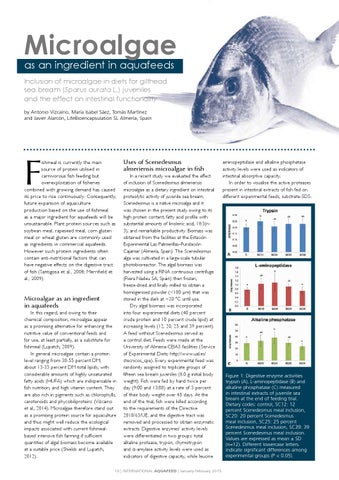Microalgae as an ingredient in aquafeeds Inclusion of microalgae in diets for gilthead sea bream (Sparus aurata L.) juveniles and the effect on intestinal functionality by Antonio Vizcaíno, María Isabel Sáez, Tomás Martínez and Javier Alarcón, LifeBioencapsulation SL Almería, Spain
F
ishmeal is currently the main source of protein utilised in carnivorous fish feeding but overexploitation of fisheries combined with growing demand has caused its price to rise continuously. Consequently, future expansion of aquaculture production based on the use of fishmeal as a major ingredient for aquafeeds will be unsustainable. Plant protein sources such as soybean meal, rapeseed meal, corn gluten meal or wheat gluten are commonly used as ingredients in commercial aquafeeds. However such protein ingredients often contain anti-nutritional factors that can have negative effects on the digestive tract of fish (Santigosa et al., 2008; Merrifield et al., 2009).
Microalgae as an ingredient in aquafeeds
In this regard, and owing to their chemical composition, microalgae appear as a promising alternative for enhancing the nutritive value of conventional feeds and for use, at least partially, as a substitute for fishmeal (Lupatch, 2009). In general microalgae contain a protein level ranging from 30-55 percent DM; about 13-33 percent DM total lipids, with considerable amounts of highly unsaturated fatty acids (HUFA) which are indispensable in fish nutrition; and high vitamin content. They are also rich in pigments such as chlorophylls, carotenoids and phycobiliproteins (Vizcaino et al., 2014). Microalgae therefore stand out as a promising protein source for aquaculture and thus might well reduce the ecological impacts associated with current fishmealbased intensive fish farming if sufficient quantities of algal biomass become available at a suitable price (Shields and Lupatch, 2012).
Uses of Scenedesmus almeriensis microalgae in fish
In a recent study we evaluated the effect of inclusion of Scenedesmus almeriensis microalgae as a dietary ingredient on intestinal proteolytic activity of juvenile sea bream. Scenedesmus is a native microalga and it was chosen in the present study owing to its high protein content, fatty acid profile with substantial amounts of linolenic acid, 18:3(n3), and remarkable productivity. Biomass was obtained from the facilities at the Estación Experimental Las Palmerillas–Fundación Cajamar (Almería, Spain). The Scenedesmus alga was cultivated in a large-scale tubular photobioreactor. The algal biomass was harvested using a RINA continuous centrifuge (Riera Nadeu SA, Spain) then frozen, freeze-dried and finally milled to obtain a homogenised powder (<100 μm) that was stored in the dark at −20 °C until use. Dry algal biomass was incorporated into four experimental diets (40 percent crude protein and 10 percent crude lipid) at increasing levels (12, 20, 25 and 39 percent). A feed without Scenedesmus served as a control diet. Feeds were made at the University of Almeria-CEIA3 facilities (Service of Experimental Diets; http://www.ual.es/ stecnicos_spe). Every experimental feed was randomly assigned to triplicate groups of fifteen sea bream juveniles (8.0 g initial body weight). Fish were fed by hand twice per day (9:00 and 13:00) at a rate of 3 percent of their body weight over 45 days. At the end of the trial, fish were killed according to the requirements of the Directive 2010/63/UE, and the digestive tract was removed and processed to obtain enzymatic extracts. Digestive enzymes’ activity levels were differentiated in two groups: total alkaline protease, trypsin, chymotrypsin and α-amylase activity levels were used as indicators of digestive capacity, while leucine
10 | INTERNATIONAL AQUAFEED | January-February 2015
aminopeptidase and alkaline phosphatase activity levels were used as indicators of intestinal absorptive capacity. In order to visualise the active proteases present in intestinal extracts of fish fed on different experimental feeds, substrate-SDS-
Figure 1: Digestive enzyme activities trypsin (A), L-aminopeptidase (B) and alkaline phosphatase (C) measured in intestinal extracts of juvenile sea bream at the end of feeding trial. Dietary codes: control, SC12: 12 percent Scenedesmus meal inclusion, SC20: 20 percent Scenedesmus meal inclusion, SC25: 25 percent Scenedesmus meal inclusion, SC39: 39 percent Scenedesmus meal inclusion. Values are expressed as mean ± SD (n=12). Different lowercase letters indicate significant differences among experimental groups (P < 0.05).
